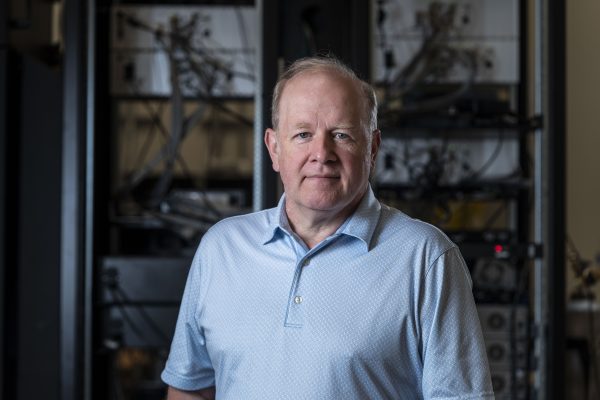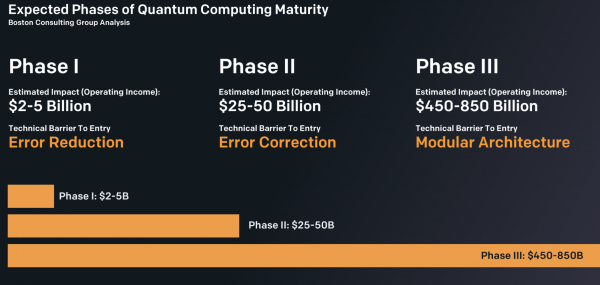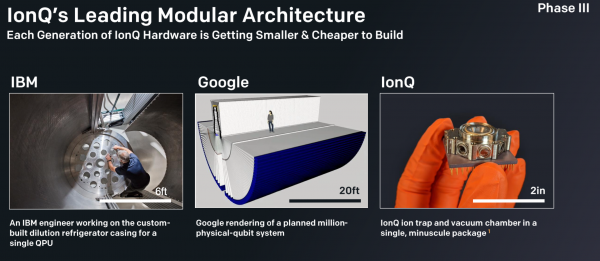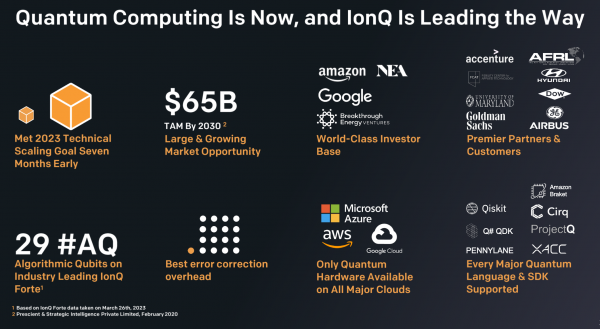Not many pure-play quantum computing start-ups have dared to go public. So far, the financial markets have tended to treat the newcomers unsparingly. One exception is IonQ, who along with D-Wave and Rigetti, reported quarterly earnings last week. Buoyed by hitting key technical and financial goals, IonQ’s stock is up ~400 % (year-to-date) and CEO Peter Chapman is taking an aggressive stance in the frothy quantum computing landscape where error correction – not qubit count – has increasingly taken center stage as the key challenge.
This is all occurring at a time when a wide variety of different qubit types are vying for dominance. IBM, Google, and Rigetti are betting on superconducting-based qubits. IonQ and Quantinuuum use trapped ions. Atom Computing and QuEra use neutral atoms. PsiQuantum and Xanadu rely on photonics-based qubits. Microsoft is exploring topological qubits based on the rare Marjorana particle. And more are in the works.
It’s not that the race to scale up qubit-count has ended. IBM has a 433-plus qubit device (Osprey) now and is scheduled to introduce 1100-qubit device (Condor) late this year. Several other quantum computer companies have devices in the 50-100 qubit range. IonQ’s latest QPU, Forte, has 32 qubits. The challenge they all face is that current error rates remain so high that it’s impractical to reliably run most applications on the current crop of QPUs.
IonQ is taking a different tack on error correction, leveraging trapped ions’ natural advantages (e.g. long coherence times) along with efforts to shrink the circuit-size required to run many applications. Building on work by the Quantum Economic Development Consortia (QED-C), IonQ has for some time been pushing a new benchmark – Algorithmic Qubit (#AQ) – that it says presents are more realistic picture of QPU capability. Earlier this this year IonQ reported reaching #AQ 29 ahead of schedule.
On last week’s earnings call, Chapman said, “In June, we announced that we will be partnering with Quantum Basel, a Switzerland-based industry group to bring two of our future systems to Europe. These systems will follow our technical roadmap, with the first one expected to reach #AQ 35 and the second system expected to reach #AQ 64. We plan to use these systems to serve European industry, government entities and research institutes with local access to IonQ’s powerful quantum systems. The beauty of this partnership is that, as our first planned on-premise hardware project in Europe, we will retain some capacity on each system, allowing us to serve other prospective customers in the region from our new European Data Center.

“At #AQ 64, classical computers will no longer be able to fully simulate an IonQ system, and as a result, we believe these systems will enable customers to tackle certain problems that even the best classical supercomputers can’t solve. We currently expect to deliver #AQ 64 by the end of 2025. We believe IonQ is the only public company today, that is executing against a roadmap that can deliver these technical results and sell systems in this time period.”
Following the earnings call, Chapman briefed HPCwire on IonQ’s progress and why it’s betting on trapped ions to be winning qubit in the near-term. (You can see IonQ’s most recent financials here on HPCwire, as well as for D-Wave and Rigetti.)
It turns out trapped ions have some characteristics that are good for error control. The ions themselves are all identical (no worry over manufacturing inconsistencies) and they exhibit long coherence times. Even the thermal requirements are less stringent than many counterparts. Trapped ion architectures have sometimes been criticized for relatively slow gate speed and scalability challenges.
Quick Trapped ion technology primer (apologies for any garbling):
Start with atoms of the right size and valence electron structure, strip off an electron to create the ion, and load ions into an evacuated chamber. IonQ uses ytterbium (Yb+) ions. Magnetic fields are used to confine the ions in a line. Lasers are used to cool the ions and limit their jiggling. The ions act as qubits. Lasers are also used to excite the ions into the desired state. Accomplishing all of this, as you might imagine, requires precision engineering and optics but steers clear of the big dilution refrigerators required by, for example, superconducting qubits.
The latest IonQ QPU (Forte) has 32 physical qubits and uses an acousto-optic deflector to precisely direct laser beams to target individual ions. This is instead of an earlier fixed path laser addressing mechanism. IonQ says, “With the aid of precision lasers, these trapped ions can then be entangled using high-quality two-qubit quantum gates between any pair of qubits in the chain. This approach is the core technology behind IonQ’s quantum computers. We believe that the all-to-all connectivity within a core, enabled by the long-range Coulomb interaction (the force between two stationary, electrically charged particles) is a significant and unique advantage of IonQ’s processor architecture. It enables highly efficient realizations of quantum algorithms with arbitrary internal structure.”
The big question for Chapman is how much accuracy is needed to run applications. He recalled one presenter at Quantum Beach conference saying the company’s definition of success was getting to 15 nines of accuracy. (Yes, 99. with 13 more nines).
“That would be perfect and is many years away, maybe 15-20 years away, if at all,” he said. “What we do is a little bit different. We think that you only need enough error correction to run various programs at various stages, right? You don’t have to get to perfection. I just need to get to a point where the errors, for most applications, for a given number of qubits, is good enough to run that particular application. I don’t have to be able to run millions of qubits and millions of circuits.”
“That’s really the definition of algorithmic qubits; it says that for most applications, doesn’t mean all applications, but for most applications, it needs the square of the number of the usable qubits, [which is] our #AQ number. So if you had 30 algorithmic qubits (#AQ 30), that means you could run a circuit width of about 900. For most applications that can use 30 qubits, they need about that kind of circuit. There’s some applications that need a circuit with 5000 width, and you wouldn’t be able to run on that on our processor. But likewise, there’s applications of maybe only 450 width, that would easily run.”
At a somewhat more granular level, IonQ’s Forte QPU has 32 physical qubits on which the #AQ 29 was demonstrated. A variety of things are baked into the #AQ benchmark[i] including performance on some commonly used quantum algorithms. (Link to IonQ paper (Benchmarking a trapped-ion quantum computer with 29 algorithmic qubits).
IonQ says, “IonQ Forte’s high-achieving application benchmarks are enabled by high-quality qubit operations. Component-level benchmarks indicate IonQ Forte offers an average 1-qubit gate error rate of 0.03% and an average 2-qubit gate error rate of 0.35%. For customers, this means the ability to run more operations with fewer errors than was previously possible.”
Next up is #AQ 25, expected in 2024, and #AQ 64 in 2025.
“We have people who are competitors who think that quantum is 10 years away, based on their hardware roadmaps, right, and they have a really large megafund. Google said they’re not going to have a quantum commercial quantum computer until 2028. Microsoft is probably 15 or 20 years away; they’re still trying to find their qubit (Marjorana) so it’s an interesting time,” said Chapman. “My guess is that just like ChatGPT, the world will be like a baseball bat to their head, like, ‘Oh, my God quantum is here and why did I miss it?’
Chapman says #AQ 64 will be the ChatGPT moment for quantum.
“At #AQ 64, we figure we need to have enough fidelity, not 15 nines, but enough so that you can run roughly a circuit width (~number of qubits) of 3000-4000, and be able to run those things without error. You won’t be able to run circuits which are 10,000 wide, because we won’t have enough error correction for that. So, but there’s plenty of applications that will run in that kind of circuit [and] be able to do things that supercomputers can’t do today,” said Chapman.
During the earnings call, Chapman pointed to a new paper (Molecular Symmetry in VQE: A Dual Approach for Trapped-Ion Simulations of Benzene) on work done with Oak Ridge National Laboratory as evidence of IonQ progress in making its strategy work. “Benzene is a commonly used industrial solvent and its molecular structure is a widely-used benchmark to evaluate quantum chemistry algorithms. We believe our work with Oak Ridge represents the most accurate benzene model run on a quantum computer today,” said Chapman.
The work also leveraged IonQ strategies for limiting circuit size. Here’s an excerpt from the abstract, “We employ several circuit optimization methods tailored for trapped-ion quantum devices to enhance the feasibility of intricate chemical simulations. The techniques aim to lessen the depth of the unitary coupled cluster with singles and doubles (uCCSD) ansatz’s circuit compilation, a considerable challenge on current noisy quantum devices.”
How to scale up trapped ion systems is a recurring question. As the #AQ rises, more qubits are needed. Getting to the 10,000-width circuit mentioned earlier by Chapman will be challenging. Currently, Forte has a single linear chain of ions and the ions themselves are addressed in place, not moved around to different zones as they are in Quantinuum’s architecture.
Chapman said, “We don’t know how far we can go, maybe up to 60-70 ions. We’re still working on that. At some point, you have to go to multiple chains. And so instead of just having an all-in-one chain, you could have them in 2,3, or even 100 chains. Loading hundreds or 1000 [of ions] into a single chip is not a not an issue. Years ago, we loaded 180 qubits into a chip. But because your fidelity isn’t improving, it’s not really useful. [You’re limited] to basically #AQ – that’s the maximum usable qubits. Adding more qubits students not really helping.
“To get to scale you could do a couple of things you. You could shuttle ions, although instead of shuttling individual qubits, the way Quantinuum does, you’d be shuttling the whole chain or maybe just the ends of two chains together to link them. The other way to do it would be to do a photonic interconnect. So basically, on the chip itself, use a photonic interconnect to the other chains.”
Unlike many quantum computer architectures, trapped ion avoids the need for giant dilution refrigerators to cool the system and chip. Environmental noise is still a villain but more easily controlled.
“The atoms are sitting in a little vacuum package and chilled using lasers down to almost absolute zero. But you’re not having to chill the whole machine. You’re only chilling the individual atoms sitting in this little vacuum package. Where cold comes in for us is a little bit different. If the vacuum was absolutely perfect, then the chain itself would last forever, but the vacuum is not perfect,” said Chapman.
“There’s gassing off the walls of the vacuum package, so a little bit of hydrogen, even though the vacuum is 10 times better than space. Every once in a while, a hydrogen atom might be floating along in the vacuum and hit our 32 atoms, and they scatter like billiard balls, and computation comes to an end. We have both room temperature areas and [localized cool areas] at 4 Kelvin temps. At 4K, the hydrogen is still there, but its energy has gone away because you’ve killed it. The hydrogen still comes along and occasionally hits the 32 atoms, but bounces off because it doesn’t have enough energy [disrupt the chain].”
At #AQ 64, Chapman thinks there will be many application areas with machine learning and financial services as strong early candidates. Wall Street seems to agree and to be rewarding both the steady technical progress and financial gains. Don’t get the wrong idea. The second quarter net loss was $43.7 million (adjusted EBITDA loss was $19.4 million) while revenue was $5.5 million, above the high end of the previously provided range, and 111% growth compared to $2.6 million in the prior year. The deal with Basel Quantum drove most of that revenue.
The public markets have generally been tough on the few pure-play quantum companies, which have gone public via the SPAC mechanism. Both D-Wave and Rigetti had faced the threat of delisting. IonQ has fared better.
Asked why IonQ went public so early, Chapman said, “IonQ is certainly one of the best funded companies. We have $500 million sitting in a bank account and that protects us from downturns [like what’s] happening in the VC markets. I can tell you why we went public. If you remember, we had just raised money at the beginning of COVID, and people were talking about having a recession, or even a depression, 40% unemployment. We’d raised about $60 million. That would give us kind of a runway of two or three years.
“Now, all of a sudden, we might be in a depression, because of COVID, and maybe we would not be able to raise [more money] because VCs shut down during depressions. This opportunity came along to go public, which would give us enough money to ignore COVID. It turns that COVID did not generate a depression. It turned out it was something else, it was inflation, and a war and in Ukraine and other factors, so today people can’t raise money. VCs are going through massive down rounds.”
For now, IonQ is sitting pretty. Its bet on trapped ion qubit technology looks promising but like all the other qubit modalities, not yet ready for prime time. Whether the company’s strategy that more modest error correction, judicious circuit-size reduction, and leveraging the trapped ion technology inherent strengths will pay off remains to be seen. There are so many different approaches to qubits and quantum computer architecture that it’s difficult to pick clear winners.
Chapman is a realist.
“This is a little controversial, but I think that there’s other qubit modalities, longer term that might be better. It’s just that in the next five to 10 years, they’re not going to be where we are today. So I’m happy to have the market to myself, sure, you know, for several years. But if you said to me 15 or 20 years from now, what qubit modality do you think I think you might be using? I don’t know, neutral atoms might be an interesting platform in that timeframe or something else,” said Chapman.
Stay tuned.
[i] Excerpt from IonQ paper, Benchmarking a trapped-ion quantum computer with 29 algorithmic qubits, https://arxiv.org/pdf/2308.05071.pdf
“#AQ is a volumetric benchmark [25] in which six classes of algorithm, corresponding to six practical applications (Hamiltonian simulation, phase estimation, quantum Fourier transform, amplitude estimation, variational quantum eigensolver (VQE) simulation, and Monte Carlo sampling), are run on a quantum computer. Each class of algorithm implements a number of different circuits for each width (number of qubits) of each application. For example, quantum Fourier transform on each distinct width has three different circuits which need to be run successfully to claim a pass for each distinct width. The circuits are provided in a standard form within a QED-C repository [26], and this form is used to define the width wc and number of two-qubit gates dc of each circuit c. Note that these values relate to the size of the circuit before any device-specific compilation is performed.”







0 Comments